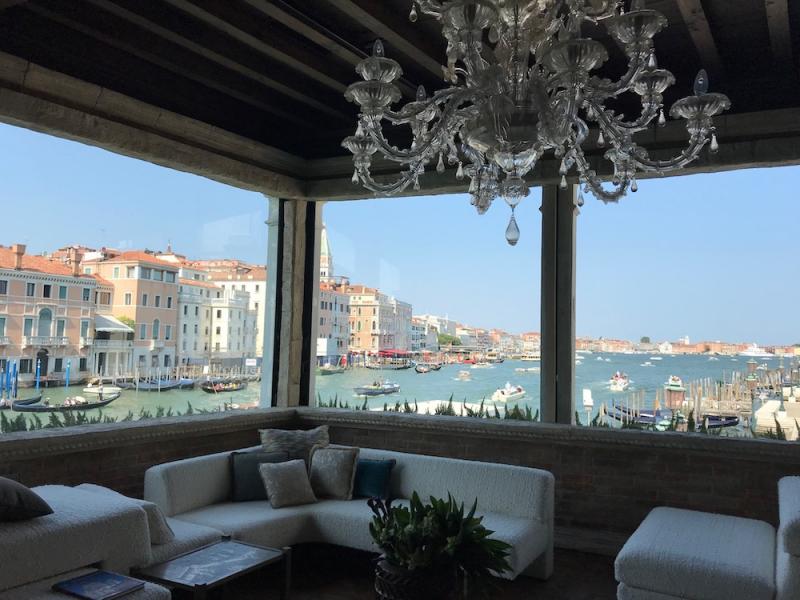For well over a century (since 1895) the Venice Biennale has been a showcase for the world’s contemporary art. Great names of the art world have been exhibited there in the past – Henry Moore and Lucian Freud in the British Pavilion; and Edward Hopper, Jasper Johns and Jackson Pollock in the American, for instance. Now we have the likes of more controversial figures like Tracy Emin and Damien Hirst. Will they too stand the test of time?
Every two years people flock to the ‘Olympics of the Art World’ to see the shock of the new, the avant garde, and the sometimes frankly weird, displayed against the most beautiful backdrop of Venetian architecture.
It’s almost as if Venice has two separate kinds of art-loving tourists: those who come for the abundance of paintings by Venetian masters of the past such as Canaletto, Tintoretto, Titian, Veronese… and those who come to face the challenges of a different kind of new art work with videos, installations, political messages – and very little actual painting.
The Colnaghi Foundation has this year for the first time opened its doors to Biennale visitors in an attempt to bring together the two sides: old masters and contemporary art, to persuade a generation of younger art lovers that the art of the past can sit happily alongside modern pieces, breaking down barriers and, it is hoped, convince more people to accept and even enjoy this marriage of styles.

Interestingly, the Colnaghi Foundation has its origins with an Italian manufacturer of fireworks, Giovanni Torre, in Paris in 1760. He moved to London and set up a partnership with Paul Colnaghi specialising in prints and engravings. They seized the opportunity to snap up the old masters suddenly flooding the market when death duties were first introduced in 1894, causing aristocrats to begin selling off their collections. The business prospered thanks to rich American buyers, and Colnaghi now has offices in London and New York with currently a strong interest in Spanish old master paintings.

Their Venice collection is housed in the ancient Abbazia di San Gregorio, built in the 9th century, which amazingly makes it older than St Mark’s. It occupies probably the most prestigious site in Venice, next to the Salute at the end of the Grand Canal. The entrance is an almost anonymous black door on the left just before the final bridge to the Salute. But when the door is opened, (visits by appointment) the wow factor kicks in, with an unexpected view of ancient cloisters, and the tranquillity of the place can instantly be felt. This is the perfect setting for paintings and objets d’art, with its old sun baked brickwork and gothic windows, and its high ceilinged cool rooms overlooking the Grand Canal.

But there’s more. You’re instantly aware too of modern pieces on display, carefully chosen to complement the old masters and sculpture which look as if they’ve been there for centuries. In the cloister there are tall bronze pieces looking like stylised trees, and by the lovely canal entrance solid geometric panels frame the central marble vessel.

All this has been masterminded by Chahan Minassian, brought in by the Foundation to add spice to the mixture so that you look with a new pair of eyes at what you see around you. It was Chahan who designed the stunning renovation of the luxury Hôtel de Crillon in Paris, bringing it with a fanfare into the 21st century. Here his project is to arrange juxtapositions of past and present with surprises in discovering relationships between the old and the new. All the new pieces are substantial, from the huge black screens which set off the two golden figures in front, to the enormous metallic glittering chandeliers, or the black elongated exotic animals created by Harumi Klossowska de Rola, Balthus’s daughter.

Each room contains such treasures it’s hard to know where to look, but the final room on the ground floor has perhaps the greatest treasure of all, the view through its windows.
The great art expert Bernard Berenson, who acted as a go-between for rich Americans wanting to buy European pieces through Colnaghi, said that the experience of looking at art should be life-enhancing, and here we see art which is just that, but more accessible and democratic rather than old masters selling for vast sums.
This is the thinking behind the idea of the 21st century Grand Tour. In previous centuries aristocrats came to Venice and other major European cities to learn, to become cultured, and to establish collections for their great houses. The Colnaghi Foundation aims to inspire the next generation of collectors. “See what can be done,” it seems to say. “Be bold, try this with that.” It’s all about textures, quality, and colour, building a collection which includes memories, discoveries and experiences.
[THE GRAND TOUR IN VENICE from Colnaghi Foundation on Vimeo.]
‘The Grand Tour in Venice’, a book written by Jeremy Howard to accompany this exhibition for the Biennale, is a beautifully presented short history of the Grand Tour. There are fascinating extracts from the letters of visitors such as Lord Byron (“mad, bad and dangerous to know”) to Dickens. At the end of the book there are blank pages left for the modern visitor, a nice way of reminding people that we are all still participants in a Grand Tour and we should record our thoughts and experiences.
The conjunction of old masters with contemporary work rests upon the notion that two different aesthetics can coexist harmoniously. In the end it boils down to individual taste, but it’s a stimulating experience which I recommend you to try. You might just begin to see your surroundings with a new pair of eyes!
For appointments to visit the Colnaghi Foundation contact: thegrandtour@colnaghi.com
The exhibition continues until the end of the Biennale on November 24th 2019.










